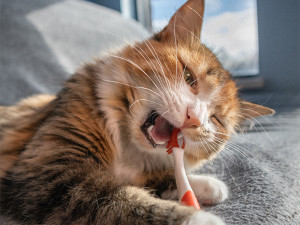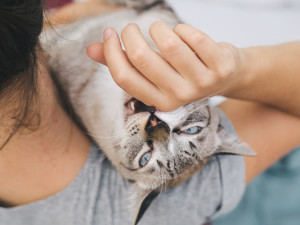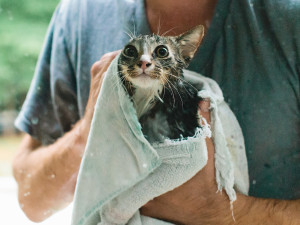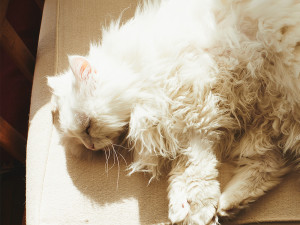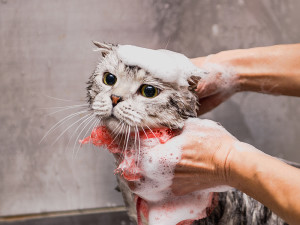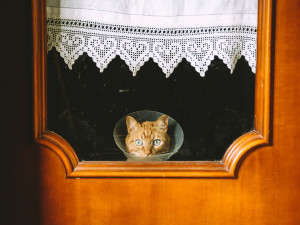The Best Cat Toothpaste
You have to keep those pearly whites clean. Here are some suggestions for toothpaste that will do the trick.
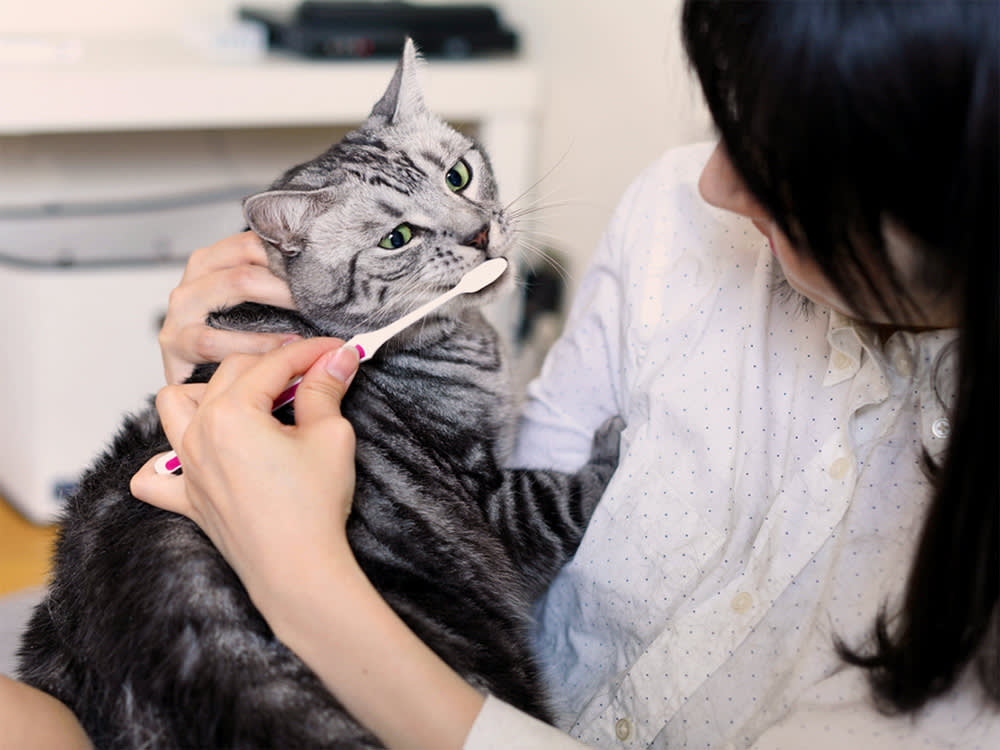
share article
In This Article:
Does My Cat Need Toothpaste?opens in a new tab Best Cat Toothpasteopens in a new tab Best Enzymatic Toothpaste for Cats opens in a new tab Best Toothpaste for Cats with Gingivitis opens in a new tab Best Homemade Toothpaste for Catsopens in a new tab What to Avoid in Cat Toothpasteopens in a new tab
Brushing your cat’s teeth may sound like a ridiculous notion, especially if they are more Hyde than Jekyll, but it’s actually a very important part of oral health. If they have ever had a dental procedure at the vet’s office, you know these are expensive endeavors. Research shows that if pet parents don’t continue dental care at home through brushing and other means, plaque returns to the teeth within hours of a dental cleaning and turns into hardened tartar within two weeks.
So, brushing is a very important step to maintain your cat’s clean teeth after a dental procedure and in protecting your wallet, too. When choosing a cat’s toothpaste, it’s important to select one that is specifically formulated for felines to avoid ingredients that may be toxic or unhealthy for them.
Most cat toothpastes are also flavored to be especially appealing to cats; think tuna or chicken instead of mint. Products approved by the Veterinary Oral Health Council (VOHC) have undergone additional evaluation and may be more reputable in their claims. Some popular options include Petsmile Professional pet toothpaste, Virbac CET Enzymatic toothpaste, and Healthymouth toothpaste. Even if your cat won’t tolerate toothpaste, brushing with a plain toothbrush can still be an effective strategy, so don’t give up.
It can be difficult to assess cat toothpastes and determine which one is best because there have been very few scientific studies that actually compare different products and evaluate their effectiveness at reducing dental disease. The VOHC seal of approvalopens in a new tab is a good starting point for finding more reputable products. In order to get this seal, a manufacturer must apply and provide data from randomized trials to show the product’s effectiveness at reducing plaque and/or calculus.
There is no requirement to show that these products actually reduce dental disease in the long run, however, and no independent studies are conducted to confirm the findings of the manufacturers, so we must take these limitations into consideration as well. In most cases, the best toothpaste for your cat will be the one they like the best, so long as it is safe and intended for cats. The more enjoyable the experienceopens in a new tab is for your cat, the more likely you will be able to easily build it into your routine and keep up with brushing regularly.
Does my cat need toothpaste?
Not really, but it can help. The mechanical action of brushing your cat’s teeth, even with no toothpaste at all, is very effective at removing plaque from the surface of the teeth. It is the brushing action that is most important. The trick is to get your cat to play along, and this is where toothpaste can actually help.
Cat toothpastes are flavored to appeal to your cat. With choices like tuna, chicken, or seafood, it can enhance the experience and entice your cat to cooperate. In addition to using a yummy toothpaste, you’ll want to employ other tactics to make brushing a positive experience for your cat.
Start very gradually by allowing your cat to sniff, chew, or lick the toothbrush and/or toothpaste. Use rewardsopens in a new tab, such as treats, toys, or praise, to encourage cooperation and keep the sessions very short at first. As your cat gets more comfortable with these initial phases, you can start working towards brushing the teeth.
Is toothpaste bad for cats?
Toothpastes intended for cats are not bad for them, but human toothpastes can be dangerous for cats and should never be used. Some ingredients — including fluoride, foaming agents, and/or xylitol — in human toothpastes can be toxic or unhealthy to pets. Because cats don’t routinely spit out their toothpaste after brushing, unlike humans, whatever is in the toothpaste must be safe for them to swallow and ingest.
Cat-specific toothpastes, especially those with the VOHC seal of approval, are safe for this purpose. It’s also important to use a cat-specific toothpaste so that the flavor will be enjoyable and will encourage your cat to cooperate with brushing. Using mint-flavored products can be unpleasant for cats and may create an aversion to the whole tooth brushing experience.
What should I look for in a good cat toothpaste?
Important features of cat toothpastes include the VOHC seal of approval, effective ingredients to control plaque, and delicious, cat-friendly flavors. Be sure to check for the following:
OHC Seal of Approval: This is a product evaluation provided through an independent organization. They review randomized trials conducted on the products to assess whether the product actually meets the manufacturer’s claim to reduce plaque and/or tartar.
Effective plaque-reducing ingredients: In order to be beneficial, the toothpaste should contain specific ingredients that will reduce plaque. This includes enzymes with antimicrobial effects and/or gentle abrasives like silicates that help to remove debris.
Flavor: Many cats have very finicky palates, so choose a flavor that will appeal to your cat. You may need to test out a few different flavors to find one that your cat approves of.
The best cat toothpaste
It’s worth reiterating that the best cat toothpaste will be the one your cat likes, as long as it is safe for cats. Toothpaste should help improve your cat’s cooperation and make the experience more enjoyable. If your cat doesn’t like the flavor of the toothpaste, it is not worth using. You will not be able to brush as thoroughly or as regularly if your cat is resisting. That said, some good options to choose from include:
Petsmile Pet Toothpasteopens in a new tab: This toothpaste has the VOHC seal of approval. Its active ingredient is called calprox, and it prevents plaque and bacteria from sticking to the surface of the teeth. Flavor options include rotisserie chicken, London Broil, and “Say Cheese.”
Healthymouth toothpaste kit:opens in a new tab Healthymouth uses a variety of ingredients to soften plaque, making it easier to remove with brushing. Their cat toothpaste comes in original flavor only. This product also contains cinnamonopens in a new tab, which can be unhealthy for cats in large amounts, so be sure to follow the directions carefully.
Best enzymatic toothpaste for cats
In theory, enzymatic toothpastes use the action of enzymes for their antimicrobial effects and to reduce plaque. Many toothpastes may claim to have enzyme activity; however, there is no guarantee this is actually the case. There are currently no VOHC approved enzymatic toothpastes so keep that in mind when assessing these claims.
Virbac CET Toothpaste:opens in a new tab This product has been around for a while, and many veterinarians and pet parents have found it helpful. Some of the best parts about it are that there are many flavors to choose from, so your cat can take their pick. There are also trial-size packets available, so you can see if it suits your kitty before committing to a full-sized package.
Vetoquinol Enzadent Enzymatic Toothpasteopens in a new tab: Vetoquinol uses enzymes including lactoperoxidase, lactoferrin, and lysozyme which they claim mimic the action of saliva in preventing plaque and killing microbes. This brand comes in poultry flavor.
Cat toothpaste for gingivitis
Gingivitis is inflammation of the gums. It is the body’s reaction to plaque on the surface of the teeth. Any toothpaste that helps to reduce plaque formation will be effective in helping to reduce the risk of gingivitis. And of course, the action of brushing will be the most important way to reduce plaque and protect your cat’s gums from gingivitis.
Petsmile Pet Toothpasteopens in a new tab: This toothpaste, which is listed in the overall “best” category as well, has been evaluated for its claims to reduce plaque, which in turn, can reduce the risk of gingivitis.
Healthymouth toothpaste kit:opens in a new tab This product, also listed under our pick for “best cat toothpaste,” has also been evaluated by the VOHC for its claims to reduce plaque formation and thus the risk of gingivitis.
Best homemade toothpaste for cats
It’s important to keep in mind that your cat cannot spit out toothpaste the way that you do, so homemade and DIY toothpaste recipes intended for people are not usually safe for cats who will ingest all of the ingredients.
Also, it’s worth reiterating that the mechanical action of brushing is the most effective and important part of tooth brushing. Toothpaste is really just an added perk. If you don’t have any cat-safe toothpaste on hand, you can still make a huge difference in your cat’s oral hygiene by brushing alone.
Consider the following if you want a DIY cat toothpaste option:
Water alone: Yes, it may sound silly, but water can work just fine in combination with the right toothbrush or slightly abrasive material like gauze to help remove plaque. If your cat doesn’t like the taste of toothpaste or has food allergies or other health problems that make it tough to find a safe option, brush with water.
Try something tasty: While it may not have plaque-fighting powers, dipping your cat’s toothbrush in something you know they like, such as canned tuna juice or a tiny dab of low- fat yogurt, it’s much more likely that your cat will allow the bristles to touch their teeth.
What should I avoid when choosing a toothpaste for my cat?
When selecting a toothpaste for your cat, you’ll want to avoid any products that may contain toxic or unhealthy ingredients. Also keep in mind your cat’s specific health problemsopens in a new tab as certain ingredients may not be a good choice for cats with food allergiesopens in a new tab, diabetesopens in a new tab, or kidney disease. If you have any doubts, speak with your vet about the best options for your cat’s particular needs. In general, try to avoid the following:
Toothpastes formulated for human use: Human toothpastes are meant to be spit out, not ingested. Therefore, they contain ingredients that may be OK for brushing but not safe for ingestion, especially for cats. Some ingredients that can be especially harmful to cats include foaming agents and fluoride.
Sweeteners, such as xylitol: This is really a concern for dogs, not cats, as xylitol can cause opens in a new taba life-threatening drop in blood-sugar and liver damage in dogs. Cats do not react the same way, and so far, research has not shown cats to develop these problems after ingesting xylitol. It might be safer to steer clear of these products anyway just to be safe, especially if there are also dogs in the home.
FAQs (People also ask):
How often should I brush my cat’s teeth?
Brushing a minimum of three times a week is what’s effective. Anything less will not reduce plaque formation.
My cat refuses to let me brush their teeth. What should I do?
Start over with baby steps. You may need to start by just letting your cat sniff the toothbrush, and give them a reward like a yummy treat or toy after each session to create a positive association.
You can also try dipping the toothpaste in something flavorful to entice your cat to lick or bite it. Each session should end on a positive note. Never restrain your cat or force the toothbrush into their mouth; this can create fear, distrust, and avoidance.
Are there alternatives to toothbrushes for cleaning my cat's teeth?
There are other productsopens in a new tab that may help to reduce plaque including special diets, chews, or water additives. None of these are as effective as the mechanical brushing action of removing plaque, though. If your cat does not like the toothbrush, you can also try using a piece of gauze wrapped around your finger to create a mildly abrasive surface.
Can you use dog toothpaste on cats?
Many pet toothpastes are labeled for use in both dogs and cats, so check the label to see if your dog’s toothpaste is appropriate for cats. If a product is strictly labeled for dogs, it may contain ingredients that are not appropriate for cats, or the flavoring may not be appealing to cats. Always check with your vet if you are wondering about the safety of a product before using it on your cat.
References:

Dr. Amy Fox, DVM
Amy Fox, DVM is a small animal veterinarian in New York City. A lifelong animal lover, Dr. Fox studied biology in college and then worked as a veterinary nurse before pursuing veterinary school at Cornell University. She has worked in many different settings including shelter medicine, emergency medicine, general practice, and animal cruelty and forensics. She is especially interested in nutrition, preventative medicine and care for senior pets. Dr. Fox also enjoys writing about veterinary medicine and teaching. In her free time she loves to cook, garden, and go for long runs.
Related articles
![fluffy white cat]() opens in a new tab
opens in a new tabLet the Cat Fur Fly
A professional groomer sheds some light on how to keep cat hair under control.
![Cat being washed by a groomer]() opens in a new tab
opens in a new tabDoes My Cat Need a Professional Groomer?
If you thought your cat was a self-cleaning evolutionary marvel, you’re not wrong but...
![Happy woman and cute cat playing with disco ball glitter confetti at home.]() opens in a new tab
opens in a new tabHow to Raise Your Cat Parenting Game in 2024
Make this new year a great one for your kitty.
![cat with cone after vet visit]() opens in a new tab
opens in a new tabDoctor’s Orders: Cat Vet Visits Are Essential
Get thy cat to a vet, even if it’s a struggle to get them out the door.
![Kitten sitting on a blanket]() opens in a new tab
opens in a new tab7 Steps to Keep Your New Kitten Happy and Healthy
With great cuteness comes great responsibility. A vet breaks down everything you need to know when you bring home a new kitten.
